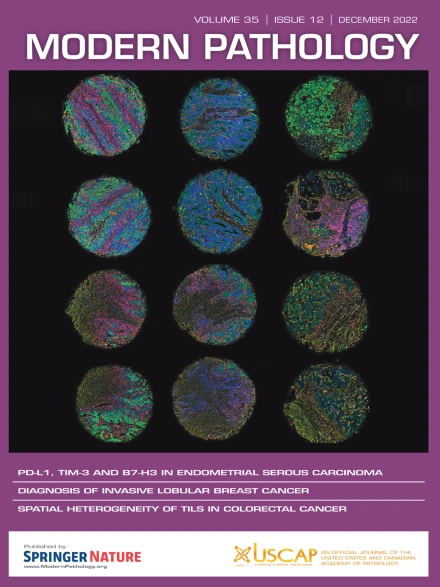CRTC1/3::MAML2融合体和LINC00473在乳腺、唾液腺和皮肤黏液表皮样癌和汗腺瘤中的RNA原位杂交检测
IF 5.5
1区 医学
Q1 PATHOLOGY
引用次数: 0
摘要
涉及MAML2的基因组重排已被报道发生在不同解剖部位的粘液表皮样癌(MEC)中,以及良性的汗腺瘤。根据位置的不同,maml2重排肿瘤可能与其他诊断实体(包括其他唾液腺恶性肿瘤和皮肤模拟肿瘤)具有形态学重叠。在某些情况下,可能需要通过荧光原位杂交(FISH)或下一代测序(NGS)检测CRTC1::MAML2或不太常见的CRTC3::MAML2重排来帮助确诊。然而,这样的测试可能是耗时的,相对昂贵的,并且无法在许多病理实验室。我们描述了一种针对CRTC1::MAML2和CRTC3::MAML2重排的复发断点的原位杂交(ISH)定制BaseScope检测的开发和验证。此外,我们研究了LINC00473 RNAscope作为MAML2融合状态的替代标记物的诊断效用。据报道,LINC00473是CRTC1::MAML2癌蛋白下游的一种长链非编码RNA。我们评估了227例患者,包括30例涎腺和2例乳腺MEC, 14例皮肤和8例乳腺汗腺瘤,173例代表bbbb20个潜在的组织学实体,通过BaseScope对每个融合转录物的存在进行鉴别诊断,以及一部分病例(n=205)通过RNAscope检测LINC00473。RNA ISH通过显色信号直接可见,大多数情况下可以阳性识别MAML2融合伴侣。总的来说,RNA ISH在正交试验中显示出高度的一致性,CRTC1/3::MAML2 BaseScope的灵敏度为93%,特异性为100%,而LINC00473 RNAscope的灵敏度为92%,特异性为99%。RNA ISH用于CRTC1/3::MAML2重排和LINC00473是FISH和NGS的合理、及时和具有成本效益的替代品。这些标志物可以提供准确诊断的手段,以确保MEC和ha肿瘤的适当治疗,这些肿瘤可以出现在多个解剖部位,并被广泛的病理学家遇到。本文章由计算机程序翻译,如有差异,请以英文原文为准。
RNA In Situ Hybridization Detection of CRTC1/3::MAML2 Fusions and LINC00473 in Mucoepidermoid Carcinomas and Hidradenomas of Breast, Salivary Glands, and Skin
Genomic rearrangements involving MAML2 have been reported in mucoepidermoid carcinoma (MEC) arising in various anatomical sites, as well as the benign counterpart of hidradenoma (HA). Depending on the location, MAML2-rearranged neoplasms may share morphologic overlap with additional diagnostic entities, including other salivary gland malignancies and cutaneous mimics. In some cases, detection of a CRTC1::MAML2 or less common CRTC3::MAML2 rearrangement by fluorescence in situ hybridization (ISH) or next-generation sequencing may be necessary to help confirm the diagnosis. However, such testing can be time consuming, relatively expensive, and unavailable in many pathology laboratories. We describe the development and validation of an ISH custom BaseScope assay targeting the recurrent breakpoints of CRTC1::MAML2 and CRTC3::MAML2 rearrangements. Moreover, we investigated the diagnostic utility of LINC00473 RNAscope as a surrogate marker for MAML2 fusion status. LINC00473 is a long noncoding RNA reportedly downstream of the CRTC1::MAML2 oncoprotein. We evaluated 227 patient cases, including 30 salivary gland and 2 breast MEC, 14 cutaneous and 8 breast HA, and 173 cases representing >20 potential histologic entities in the differential diagnosis for the presence of each fusion transcript by BaseScope, and a subset of cases (n = 205) for the detection of LINC00473 by RNAscope. RNA ISH was directly visualized by chromogenic signal, and the MAML2 fusion partner could be positively identified in the majority of cases. Overall, RNA ISH demonstrates high concordance with orthogonal testing, with CRTC1/3::MAML2 BaseScope showing 93% sensitivity and 100% specificity and LINC00473 RNAscope showing 92% sensitivity and 99% specificity. RNA ISH for CRTC1/3::MAML2 rearrangements and LINC00473 represent reasonable timely and cost-effective alternatives to fluorescence ISH and next-generation sequencing. Such markers may provide the means for accurate diagnosis to ensure appropriate therapy of MEC and HA—neoplasms that can arise in multiple anatomical sites and be encountered by a wide range of pathologists.
求助全文
通过发布文献求助,成功后即可免费获取论文全文。
去求助
来源期刊

Modern Pathology
医学-病理学
CiteScore
14.30
自引率
2.70%
发文量
174
审稿时长
18 days
期刊介绍:
Modern Pathology, an international journal under the ownership of The United States & Canadian Academy of Pathology (USCAP), serves as an authoritative platform for publishing top-tier clinical and translational research studies in pathology.
Original manuscripts are the primary focus of Modern Pathology, complemented by impactful editorials, reviews, and practice guidelines covering all facets of precision diagnostics in human pathology. The journal's scope includes advancements in molecular diagnostics and genomic classifications of diseases, breakthroughs in immune-oncology, computational science, applied bioinformatics, and digital pathology.
 求助内容:
求助内容: 应助结果提醒方式:
应助结果提醒方式:


